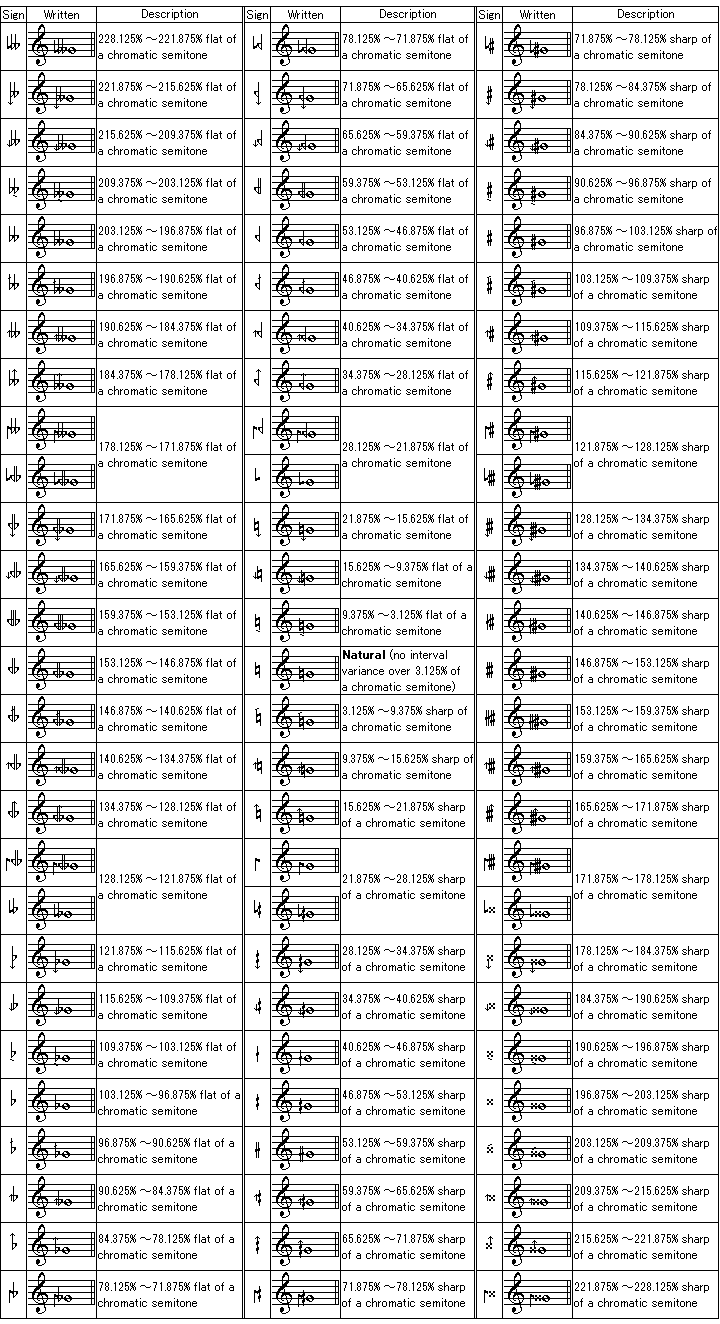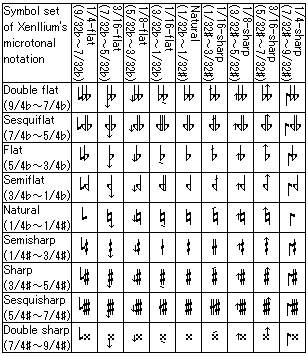User:Xenllium/Xenllium's microtonal notation
Here is a microtonal notation proposed by Xenllium on 15 June 2022.
This notation is valid for any tuning system in which chromatic semitone is represented by between 1 and 16 steps. Alternatively, EDOs with sharpness value between 1 and 16 can apply this notation. Not only for EDOs, this notation can be used for some regular tunings which have 7-tone MOS or 1/7-octave period.
Symbol set
The symbol set comprises traditional accidentals (sharps, flats, and naturals), Stein-Zimmermann quartertone accidentals (semisharps and semiflats), and additional symbols to represent microtone intervals. Some accidentals in this notation are borrowed from Helmholtz-Ellis notation and arranged to represent microtone intervals including quarter-tone, sixth-tone, eighth-tone, tenth-tone, twelfth-tone, fourteenth-tone and sixteenth-tone.
1) The traditional accidentals, as specified in this microtonal notation, modify the note by a chromatic semitone (apotome, 2187/2048).
2) The Stein-Zimmermann quartertone accidentals modify the note by half of a chromatic semitone.
3) To modify the note by a quarter of a chromatic semitone, use symbols for septimal comma in Helmholtz-Ellis notation, but also combining to quartertone accidentals.
4) To modify the note by around 1/5 or 1/6 of a chromatic semitone, use symbols for syntonic comma in Helmholtz-Ellis notation, but also combining to quartertone accidentals.
5) To modify the note by around 1/7, 1/8, 1/9 or 1/10 of a chromatic semitone, use symbols for vicesimotertial comma (left-combining up/down arrow) in Helmholtz-Ellis notation, but also combining to quartertone accidentals.
6) To modify the note by around 1/16 of a chromatic semitone, use symbols for undevicesimal comma, tridecimal third-tone or raising undecimal quartertone in Helmholtz-Ellis notation.
Usage guide
A usage guide for each sharpness value will be provided here.
Sharp-1 and sharp-2
In sharp-1 EDOs (12, 19, 26, 33, 40 and 47 EDOs) and regular tunings which have 5L 2s scale (eg. Pythagorean, meantone, schismic and superpyth), traditional notation can be used.
In sharp-2 EDOs (17, 24, 31, 38, 45 and 52 EDOs) and regular tunings which have 3L 4s scale (i.e. neutral third scales), the Stein-Zimmermann quartertone accidentals can be used.
Sharp-3 and sharp-6
In sharp-3 EDOs (22, 29, 36, 43, 50, 57 and 64 EDOs) and sharp-6 EDOs (37, 44, 51, 58, 65, 72, 79, 86, 93 and 100 EDOs), quartertone accidentals with combined arrow are used for modifying the note by 1/6 of a chromatic semitone. This accidentals can also be used for regular tunings which have 1L 6s scale (eg. porcupine and squirrel) or 2L 5s scale (eg. gravity).
Sharp-4 and sharp-8
In sharp-4 EDOs (27, 34, 41, 48, 55, 62, 69 and 76 EDOs) and regular tunings which have 6L 1s scale (eg. tetracot), accidentals for 1/8-tone are used for modifying the note by a quarter of a chromatic semitone. This accidentals are used for modifying the note by a septimal comma in Helmholtz-Ellis notation.
In sharp-8 EDOs (54, 61, 68, 75, 82, 89, 96, 103, 110 and 117 EDOs) and regular tunings which have pseudo-equalized 5L 2s scale, accidentals for 1/16-tone are used for modifying the note by a 1/8 of a chromatic semitone. This accidentals are used for modifying the note by a vicesimotertial comma in Helmholtz-Ellis notation.
Sharp-5 and sharp-10
In sharp-5 EDOs (32, 39, 46, 53, 60, 67, 74, 81 and 88 EDOs) and sharp-10 EDOs (71, 78, 85, 92, 99, 106, 113, 120, 127, 134 and 141 EDOs), quartertone accidentals with combined arrow are used for modifying the note by 1/10 or 1/5 of a chromatic semitone. Combining a small up/down arrow to the left of a quartertone accidental modifies the note by a 1/10 of a chromatic semitone, and combining an arrow to the top/bottom of a quartertone accidental modifies the note by 1/5 of a chromatic semitone. This accidentals can also be used for regular tunings which have 4L 3s scale (eg. sixix and amity) or pseudo-equalized 1L 6s scale.
Sharp-7
In sharp-7 EDOs (42, 49, 56, 63, 70, 77, 84, 91, 98 and 105 EDOs) and regular tunings which have 1/7-octave period (eg. sevond and absurdity), accidentals for 1/14-tone are used for modifying the note by a 1/7 of a chromatic semitone. These accidentals include small arrows (combined with the left of natural, sharp, flat, double-sharp or double-flat, or the top/bottom of semisharp, semiflat, sesquisharp or sesquiflat), semiflat with a stroke, Helmholtz-Ellis accidentals for undecimal quartertone and tridecimal third tone (except lowering by one undecimal quartertone, which is the same shape as Stein-Zimmermann semiflat symbol).
Sharp-9
In sharp-9 EDOs (59, 66, 73, 80, 87, 94, 101, 108, 115, 122 and 129 EDOs) and regular tunings which have pseudo-equalized 3L 4s scale (eg. artoneutral), accidentals for 1/18-tone are used for modifying the note by a 1/9 of a chromatic semitone. These accidentals include small arrows (combined with the left of natural, sharp, flat, double-sharp or double-flat, or the top/bottom of semisharp, semiflat, sesquisharp or sesquiflat), semiflat with a stroke, Helmholtz-Ellis accidentals for septimal comma, undecimal quartertone and tridecimal third tone (except lowering by one undecimal quartertone).
Sharp-11
In sharp-11 EDOs (83, 90, 97, 104, 111, 118, 125, 132, 139, 146 and 153 EDOs) and regular tunings which have pseudo-equalized 6L 1s scale (eg. undetrita), accidentals for 1/22-tone are used for modifying the note by a 1/11 of a chromatic semitone. These accidentals include small arrows (combined with the left of semisharp, semiflat, sesquisharp or sesquiflat, or the top/bottom of natural, sharp, flat, double-sharp or double-flat), combining stroke with the top/bottom of natural, sharp, flat, double-sharp, double-flat, semiflat and sesquiflat, Helmholtz-Ellis accidentals for septimal comma, undecimal quartertone and tridecimal third tone (except lowering by one undecimal quartertone).
Sharp-12
In sharp-12 EDOs (95, 102, 109, 116, 123, 130, 137, 144, 151 and 158 EDOs) and regular tunings which have pseudo-equalized 4L 3s scale, accidentals for 1/24-tone are used for modifying the note by a 1/12 of a chromatic semitone. These accidentals include small arrows (combined with the top/bottom of quartertone accidentals), combining stroke with the top/bottom of natural, sharp, flat, double-sharp, double-flat, semiflat and sesquiflat, Helmholtz-Ellis accidentals for septimal comma, undecimal quartertone and tridecimal third tone.
Sharp-13
In sharp-13 EDOs (107, 114, 121, 128, 135, 142, 149, 156, 163 and 170 EDOs) and regular tunings which have pseudo-equalized 2L 5s scale, accidentals for 1/26-tone are used for modifying the note by a 1/13 of a chromatic semitone. These accidentals include small arrows (combined with the left or the top/bottom of quartertone accidentals), combining stroke with the top/bottom of natural, sharp, flat, double-sharp, double-flat, semiflat and sesquiflat, Helmholtz-Ellis accidentals for septimal comma, undecimal quartertone and tridecimal third tone (except lowering by one undecimal quartertone).
Sharp-14
In sharp-14 EDOs (112, 119, 126, 133, 140, 147, 154, 161, 168, 175 and 182 EDOs) and regular tunings which have 1/7-octave period, accidentals for 1/28-tone are used for modifying the note by a 1/14 of a chromatic semitone. These accidentals include small arrows (combined with the left or the top/bottom of quartertone accidentals), combining stroke with the top/bottom of natural, sharp, flat, double-sharp, double-flat, semiflat and sesquiflat, Helmholtz-Ellis accidentals for undecimal quartertone and tridecimal third tone.
Sharp-15
In sharp-15 EDOs (124, 131, 138, 145, 152, 159, 166, 173, 180, 187 and 194 EDOs) and regular tunings which have pseudo-equalized 5L 2s scale (eg. trinity), accidentals for 1/30-tone are used for modifying the note by a 1/15 of a chromatic semitone. These accidentals include small arrows (combined with the left or the top/bottom of quartertone accidentals), combining stroke with the top/bottom of natural, sharp, flat, double-sharp, double-flat, semiflat and sesquiflat, Helmholtz-Ellis accidentals for septimal comma, undecimal quartertone and tridecimal third tone (except lowering by one undecimal quartertone).
Sharp-16
In sharp-16 EDOs (136, 143, 150, 157, 164, 171, 178, 185, 192 and 199 EDOs) and regular tunings which have pseudo-equalized 3L 4s scale, accidentals for 1/32-tone are used for modifying the note by a 1/16 of a chromatic semitone. These accidentals include small arrows (combined with the left or the top/bottom of quartertone accidentals), combining stroke with the top/bottom of natural, sharp, flat, double-sharp, double-flat, semiflat and sesquiflat, Helmholtz-Ellis accidentals for septimal comma, undecimal quartertone and tridecimal third tone.












